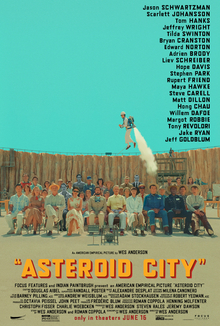I’ve soured on the works of Wes Anderson of late but after dithering for a while, I gave in and watched this one. Once again, it’s an ensemble film featuring an insane number of Hollywood luminaries and doesn’t really mean anything at all apart from the usual pathos of its characters. Yet I ended up rather liking this one because it’s very overt in telling the audience not to worry too much about it means and to just enjoy the show. It also helps that like the other Anderson films that I’ve most liked, it has more in the way of young adult characters and of course the retro-1950s science-fiction setting is great fun.
This purports to be a documentary about a stage play that is set in a fictional small town named Asteroid City. It’s so named because a meteorite struck there thousands of years ago, resulting in a crater. Many people arrive to attend a youth astronomy convention in which several youths are awarded prizes for their science projects. Among them are Augie Steenbeck, a war photographer and recent widower whose son Woodrow is one of the geniuses, along with three daughters. There’s also Midge Campball, a famous actress, with her daughter Dinah. US general Grif Gibson presides over the convention and Dr. Hickenlooper runs the local observatory. That night after the prizegiving ceremony, the attendees gather to witness the so-called astronomical ellipses phenomenon. Suddenly a spacecraft descends from the sky and an alien emerges to retrieve the piece of meteorite left on the ground before leaving. General Gibson places the town under quarantine and the government tries to suppress news about the event. The visitors bristle as they are prevented from leaving and relationships develop among them.
With this being supposedly a play even though it would be impossible to situate it on any kind of real stage, this feels more than ever like a cartoon for adults. The sets are thinly veiled props, the characters are bold stereotypes, and everything is over the top with no pretense at realism. I mean one of the kids explicitly build a death ray as a science project, the alien arrives in a UFO, it’s all wonderfully 1950s pulp science-fiction. Then there are the multiple meta levels, as it’s both a documentary with a narrator and a play, so the people we see are sometimes characters in the play and other times the actors playing them. This means that there is plenty of fourth wall breaking as the actors question what is required of them from the director and the playwright struggles with finishing the play. Underneath it all, the characters still wrestle with the usual obsessions of narcissism, loneliness and struggling to find the meaning of life, conveyed in the form of interminably long lines of self-aware dialogue. Yet the director is also telling us not to worry too much and I’m inclined to take him up on it.
Anderson will never be one of my favorite directors. Not only does his visual style remain the same across all of his films but his characters always struggle with the same things as well. There may be some humor and lighthearted moments but at their core, his characters are always desperate to reach out to other people. Here we see multiple romantic relationships awkwardly blossom throughout the quarantine period. Yet when the US military lifts the quarantine, everyone scatters and goes back to their usual lives, with the status of their new relationships left as an open question. I don’t begrudge Anderson his personal obsessions and the formula seems to work for him. But it gets boring seeing him do the same things over and over again even if the change in scenery here was fun for me. It’s gotten to the point where my wife instantly falls asleep during his films so I probably should stop adding his films into our rotation.
